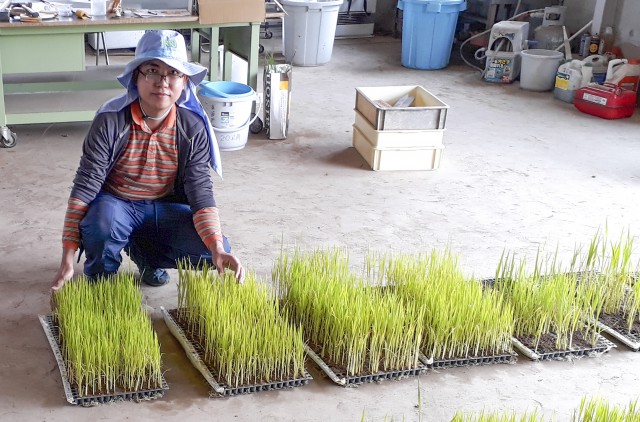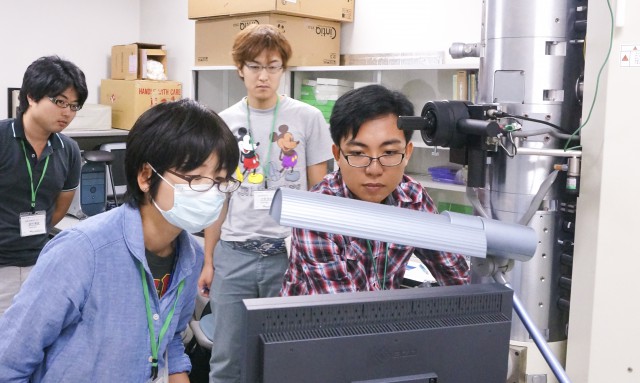 Among PhilRice’s promising young scientists, Dr. Reynante Lacsamana Ordonio, 36, has already published in high-impact journals such as Science, Nature Cell Research and Scientific Reports, and Proceedings of the National Academy of Sciences-USA. A rare feat for Filipino researchers. He is among the very few researchers at PhilRice that focus on plant molecular breeding and genetic engineering.
Among PhilRice’s promising young scientists, Dr. Reynante Lacsamana Ordonio, 36, has already published in high-impact journals such as Science, Nature Cell Research and Scientific Reports, and Proceedings of the National Academy of Sciences-USA. A rare feat for Filipino researchers. He is among the very few researchers at PhilRice that focus on plant molecular breeding and genetic engineering.
Rey is currently a postdoctoral research fellow at Nagoya University, working on rice seed germination.
A young achiever
When he was in grade school, Rey was oftentimes asked by his teachers to join quiz bee competitions, and he rarely got defeated.
“I take delight in receiving small cash prizes in white envelopes, and I always feel good giving them to my mother,” shares Rey. Despite being timid, Rey used to sell some sweets in school to add a little bit to his daily pocket money.
In high school, Rey joined the Banaag at Sining dance troupe where he gained more self-confidence. It did not take long before he discovered his other talents. In fact, he learned that he could actually do singing, writing and oration. There was a time when he represented his school in a city-wide singing contest, and he unexpectedly clinched the 2nd prize with the piece Candle in the Wind by Elton John.
He had a busy and colorful college life at the Central Luzon State University. Rey juggled being an official of the student council, a writer of the school paper, and a member of the CLSU choir called CLSU Koro.
When he was in his freshman year at CLSU, he defeated senior students in a campus-wide quiz bee on drug abuse awareness. Since then, he had been a regular contestant in on- and off-campus quiz bees including the Battle of the Brains, a nationwide quiz show in 1994 aired over PTV 4.
Not known to many, Rey initially wanted to become a veterinarian. In fact, he spent a semester at the College of Veterinary Science and Medicine in CLSU before taking BS Biology. He had to shift to a 4-year course so he could graduate immediately and help his family.
“My biggest achievement was to be the sole magna cum laude (high distinction) and class valedictorian of batch 2002. It was not an easy journey. For me, it was a dream come true,” shares Rey.
Involvement in rice research
Rey joined PhilRice in 2004 as a researcher focused on the selection of plants containing desired genetic traits related to tungro resistance through marker-aided selection (MAS). He specializes in molecular breeding. He co-leads the Golden Rice Project in PhilRice, a big-ticket project that applies biotechnology in breeding a high beta carotene rice variety funded by the Bill and Melinda Gates Foundation.
Aside from improving the nutritional value, the project aims to improve field performance of different Philippine elite rice varieties by incorporating genes for beta-carotene biosynthesis in the grains along with genes for bacterial leaf blight and tungro resistance.
Rey is also involved in the Newton Project funded by the United Kingdom and PhilRice on establishing a collection of useful rice germplasm or varieties to address climate change by mitigating carbon emissions. The study, which is in partnership with the University of York in England, aims to mitigate greenhouse gas emissions from rice straw burning.
Japan as second home
Ever since he was a young boy, Rey has always been fascinated with the Japanese culture. Hence, he set his mind on studying in Japan someday.
While at PhilRice, in 2006, he was successful in getting a scholarship from the Panasonic Scholarship to do his Master of Science in Agricultural Science at Nagoya University. That was a year before he completed his MS in Biology at CLSU in 2007.
In Japan, he learned not just about agricultural science, but the Nihongo language as well as it is a key requirement of the Foundation.
From rice, Rey shifted to sorghum for his PhD under the Monbukagakusho scholarship, a Japanese government scholarship for international students. He then worked on the analysis of gamma ray-induced sweet sorghum mutants which identified genes that can affect normal plant growth.
“Life in Japan is very simple and yet modern and extremely peaceful. I enjoy biking in Japan as my pastime. Given that Japan is a beautiful country, travelling here is a breath of fresh air,” shares Rey.
As a scientist, however, Rey spends most of his time in the laboratory. While it may sound geeky and boring, Rey feels otherwise. In the lab, he has all the time to stay focused and committed—talk about life of the mind.
Touching lives
Before he joined PhilRice, Rey taught at CLSU. He recalls that his students liked his teaching style. He is very happy about it as he does love sharing his knowledge to others.
While in Japan, for about 2 years, he did some volunteering work for International Children’s Action Network or ICAN, a non-profit organization. His task was to teach English and Filipino languages to Japanese adults. Proceeds of the organization’s work go to the poor children and women living in Payatas in Manila.
“It was a good way of relieving myself from stress,” says Rey.
Hopes in rice breeding
Modern genetic tools like gene editing can help patch rice breeding gaps, shares Rey. He adds the need to breed more varieties that are of superior qualities.
With support from the government, he believes that fast-tracking the development of better varieties with the use of modern biotechnology can address the effects of climate change to rice farming.





